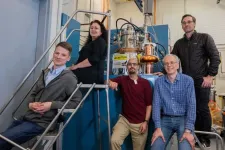(Press-News.org) BALTIMORE, March 14, 2024: Scientific research has linked a person’s microbiome to everything from gut and mental health to immunity and predisposition to cancer. This research comes at a time when there is a burgeoning interest in wellness and alternative medicine, which has fueled consumers’ curiosity about the composition of their own microbiomes.
This curiosity has led to a growing demand for direct-to-consumer (DTC) microbiome testing services. While the companies marketing these services claim to tell customers whether their microbiomes (gut, vaginal, skin…) are “healthy,” researchers from the University of Maryland, Baltimore Schools of Law, Medicine, and Pharmacy question the tests’ accuracy.
In a unique multidisciplinary collaboration, the researchers call for greater regulation of these products in a Perspectives article published March 15 in Science. Diane Hoffmann, JD, MS, Director of the Law and Health Care Program and the Jacob A. France Professor of Health Care Law at the University of Maryland Francis King Carey School of Law, led the collaboration.
The perspective is the result of a National Institutes of Health-funded study that consisted of consultations with experts in food and drug law, microbiome sciences, gastroenterology, gynecology, government regulations, and bioethics as well as focus groups with clinicians and consumers using the products.
DTC microbiome testing services identify which microorganisms are present along with their relative abundance in a fecal or vaginal sample that the consumer collects. In some cases, the test may describe the metabolic functions of the microbes observed.
“There is a perception among consumers that these products will give them a real medical diagnosis and a way to treat an ‘unbalanced’ microbiome,” said Jacques Ravel, PhD, co-author and Acting Director of the Institute for Genome Sciences and Professor of Microbiology and Immunology at the University of Maryland School of Medicine (UMSOM). “There is no scientifically agreed-upon definition of a ‘healthy’ microbiome; the microbiome is dynamic and changes frequently; there is no clinical proof that these products work; and no standardization in the processes involved.”
For consumers—who often suffer from diseases such as inflammatory bowel disease (IBD) or bacterial vaginosis (BV)—that means shelling out a lot of money for a test without a guarantee of useful or actionable medical information—and then often further investing in what companies tell them will help improve their microbiome, such as nutritional supplements including probiotics and prebiotics, or special diets. None of these interventions have been clinically validated or had their claims evaluated by the U.S. Food and Drug Administration (FDA).
“In addition to the cost, these tests could do real harm by convincing a person to delay medical care and substitute supplements for prescription medications,” added Dr. Ravel, who studies the vaginal microbiome.
“We’re calling for federal regulators with oversight of these testing companies to set standards for the analytical validity of their tests and require them to report on their performance,” said Hoffmann. “Additionally, the FDA needs to determine if DTC microbiome tests are general wellness tests or if they make diagnostic claims that could harm consumers. If it is determined that these are diagnostic tests, then FDA regulation will be required.”
In addition to the FDA, the authors write that government bodies like the National Institute of Standards and Technology (NIST) should set standards for the tests, including laboratory methods so that test results are accurate, can be trusted, and are comparable across labs; the Centers for Medicare and Medicaid Services (CMS) under the Clinical Laboratory Improvements Amendments (CLIA) should regulate the analytical validity of the tests, including the testing methods and algorithms used to formulate a report and should require the testing companies to adopt agreed upon standards and report their performance.
“We need further research and clinical evaluation before any of these companies can claim a relationship between a test result and a person’s health, or if dietary changes and supplements can improve the microbiome and someone’s health,” said Hoffman.
“There are more than 60,000 pharmacies in the United States, and these are the source for at least some of the DTC microbiome tests,” said Frank Palumbo, PhD, JD, Professor Emeritus of Practice, Sciences, and Health Outcomes Research at the University of Maryland School of Pharmacy. “Pharmacists should be made aware of the issues these unregulated laboratory tests present, since they are in a position to counsel customers who buy these products.”
All the authors agree that claims these testing companies make are premature and that additional clinical research and peer-validation is necessary before consumers can have confidence in the results. Additional co-authors were Erik von Rosenvinge, MD, Professor of Medicine in the Division of Gastroenterology & Hepatology at UMSOM and Chief of Gastroenterology at the VA Maryland Health Care System; Mary-Claire Roghmann, MD, MS, Professor of Epidemiology and Public Health at UMSOM, and Daniel McDonald, PhD, Scientific Director of the American Gut Project and the Microsetta Initiative at the University of California San Diego.
About the University of Maryland Francis King Carey School of Law
The University of Maryland School of Law was authorized by the Maryland legislature in 1813 and began regular instruction in 1824. It is the third oldest law school in the nation, but its innovative programs make it one of the liveliest and most dynamic today. Maryland Carey Law stands among five other professional schools on the University of Maryland, Baltimore campus. It has taken advantage of this location to become an integral part of the Baltimore-Washington legal and business community.
About the University of Maryland School of Medicine
Now in its third century, the University of Maryland School of Medicine was chartered in 1807 as the first public medical school in the United States. It continues today as one of the fastest growing, top-tier biomedical research enterprises in the world -- with 46 academic departments, centers, institutes, and programs, and a faculty of more than 3,000 physicians, scientists, and allied health professionals, including members of the National Academy of Medicine and the National Academy of Sciences, and a distinguished two-time winner of the Albert E. Lasker Award in Medical Research. With an operating budget of more than $1.2 billion, the School of Medicine works closely in partnership with the University of Maryland Medical Center and Medical System to provide research-intensive, academic, and clinically based care for nearly 2 million patients each year. The School of Medicine has more than $500 million in extramural funding, with most of its academic departments highly ranked among all medical schools in the nation in research funding. As one of the seven professional schools that make up the University of Maryland, Baltimore campus, the School of Medicine has a total population of nearly 9,000 faculty and staff, including 2,500 students, trainees, residents, and fellows. The School of Medicine, which ranks as the 8th highest among public medical schools in research productivity (according to the Association of American Medical Colleges profile) is an innovator in translational medicine, with 606 active patents and 52 start-up companies. In the latest U.S. News & World Report ranking of the Best Medical Schools, published in 2023, the UM School of Medicine is ranked #10 among the 92 public medical schools in the U.S., and in the top 16 percent (#32) of all 192 public and private U.S. medical schools. The School of Medicine works locally, nationally, and globally, with research and treatment facilities in 36 countries around the world. Visit medschool.umaryland.edu
About the University of Maryland School of Pharmacy
Established in 1841, the University of Maryland School of Pharmacy is ranked 14th out of more than 140 schools of pharmacy by U.S. News & World Report. The School is a thriving center for professional and graduate education, pharmaceutical care, research, and community service. Its faculty create the future of pharmacy by pioneering new roles for pharmacists in advanced clinical practice and conducting cutting-edge research in drug discovery and development, comparative effectiveness and patient-centered outcomes, and disease management. A contemporary curriculum, innovative educational experiences, and strategic professional relationships help to inspire excellence in the School’s more than 1,000 students, residents, and postdoctoral fellows. The School offers 10 academic programs: Doctor of Pharmacy; PhD programs in Palliative Care, Pharmaceutical Health Services Research, and Pharmaceutical Sciences; and MS programs in Medical Cannabis Science and Therapeutics, Palliative Care, Pharmaceutical Health Services Research, Pharmaceutical Sciences, Pharmacometrics, and Regulatory Science. With a research portfolio of more than $38.5 million in grants and contracts, the School is ranked 9th by the American Association of Colleges of Pharmacy amongst schools of pharmacy. In 2017, the School launched its exclusive Pharmapreneurship® program, which describes the School's commitment to supporting and best positioning both faculty and students to achieve their career aspirations and address our nation's health care challenges.
About the Institute for Genome Sciences
The Institute for Genome Sciences' (IGS) has been part of the University of Maryland School of Medicine (UMSOM) since 2007. IGS scientists work in diverse areas, applying genomics and systems biology approaches to better understand health issues in premature infants, women, and transgender people; to improve vaccine development; to study evolutionary biology; and to understand cancer, parasitic, fungal, and infectious diseases, as well as identifying the underpinnings of aging, brain development, addiction, and mental health. IGS also remains at the forefront of high-throughput genomic technologies and bioinformatics analyses through its core facility, Maryland Genomics which provides researchers around the world with cutting-edge, collaborative, and cost-effective sequencing and analysis.
About the University of Maryland, Baltimore
The University of Maryland, Baltimore (UMB) was founded in 1807 as the Maryland College of Medicine, which now stands as the nation’s oldest public medical school. In response to growing social and cultural needs, UMB’s mission has evolved and grown tremendously. Widely recognized as a preeminent institution, UMB serves as the academic health, law, and social work university of the University System of Maryland and is guided by a mission of excellence in education, research, clinical care, and public service.
UMB is a thriving academic health center combining cutting-edge biomedical research, exceptional patient care, and nationally ranked academic programs. With extramural funding totaling $654 million in Fiscal Year 2022, each tenured/tenure-track faculty member generates an average of $1.5 million in research grants each year. More than 3,100 faculty members conduct leading-edge research and develop solutions and technologies that impact human health locally and around the world. World-class facilities and cores, as well as interprofessional centers and institutes, allow faculty to investigate pressing questions in a highly collaborative fashion. As a result, the more than 7,000 students, postdocs, and trainees directly benefit from working and learning alongside leading experts as they push the boundaries of their fields. For a listing of the organized research centers and institutes, visit: https://www.umaryland.edu/research/umb- research-profile/research-centers-and-institutions/
END
University of Maryland, Baltimore researchers call for regulation of direct-to-consumer microbiome tests
Current lack of standards could mislead consumers
2024-03-14
ELSE PRESS RELEASES FROM THIS DATE:
Training dairy cows with positive reinforcement can turn otherwise stressful events into play
2024-03-14
Philadelphia, March 14, 2024 – Dairy cows receive a huge amount of care during their lives on a farm, but procedures, especially restraining during procedures, can be stressful for some animals. Positive reinforcement training—or training with a reward to achieve a desired behavior—has shown promise to reduce this fear in other species. In a recent study in the Journal of Dairy Science, published by the American Dairy Science Association and Elsevier, a team of researchers set out to understand whether ...
Information overload is a personal and societal danger
2024-03-14
We are all aware of the dangers of pollution to our air, water, and earth. In a letter recently published in Nature Human Behavior, scientists are advocating for the recognition and mitigation of another type of environmental pollution that poses equivalent personal and societal dangers: information overload.
With the internet at our fingertips with smartphones, we are exposed to an unprecedented amount of data far beyond our ability to process. The result is an inability to evaluate information and make decisions. Further, it can lead us to limit our social activities, feel unsatisfied with ...
Study: How home food availability affects young children’s nutrient intake
2024-03-14
URBANA, Ill. – Early childhood is an important time for learning about nutrition and establishing healthy eating behaviors. Young children rely on parents to provide food options, and the availability of food in the home affects their dietary choices. A new study from the University of Illinois Urbana-Champaign looks at changes in home food availability and nutrient intake for children from 2 to 4 years old.
“It's important to understand how the environments that children are in can influence their diet and nutrition. What types of foods and beverages are available in the home, and how accessible ...
A pioneering way to target the culprit behind a deadly liver cancer
2024-03-14
Cell division is the generative spark of nearly every lifeform on Earth. But if healthy growth goes unchecked, cell division can turn lethal, overwhelming the organism. Such is the case with so-called oncogenes. When altered by a mutation, these growth-moderating genes go haywire, producing a geyser of cancer cells as a result. Oncogenes are also insidiously adept at generating tumors that over time become genetically “independent” from their origin, so it has been exceedingly difficult for scientists to shut down their replication ...
Clay Wright receives MIRA funding to create new molecular tools
2024-03-14
Clay Wright, assistant professor in the College of Agriculture and Life Sciences’ Department of Biological Systems Engineering, was awarded a prestigious Maximizing Investigators' Research Award (MIRA) from the National Institute of General Medical Sciences, part of the National Institutes of Health.
The funding is aimed at providing the investigator, versus a specific project, enhanced stability and flexibility for further discovery, enhancing scientific productivity and the chances for significant breakthroughs outside the initial scope of the project.
This recognition supports Wright's innovative work in understanding ...
Shade-grown coffee demonstrates the benefits of combining agriculture and conservation, an Oxford Brookes University study reveals
2024-03-14
Increasing shade cover over coffee plants can increase biodiversity and provide new ways to combine agriculture and conservation, a new study has revealed.
Coffee grown in high shade, with more than 30% canopy cover, provides a home to more plant and animal species than coffee grown in the sun or on low shade farms with less than 30% canopy cover, the study found.
Preserving biodiversity is good news for farmers as it means better natural pest control, and improved soil ...
Mind the mask!
2024-03-14
Building on what was learnt to one's cost during the pandemic to improve health management in the future. This motivation has led scholars and researchers to take up the topic and investigate various aspects beyond the emergency phase.
Just recently, an article by the first signatory and corresponding author, Giuseppe Alessandro Veltri of the Department of Sociology and Social Research of the University of Trento, focused on the public health guidelines adopted during the pandemic. The research team assessed the effect perceived ...
Dr. Lawrence J. Rosenblum elected IEEE Fellow
2024-03-14
WASHINGTON – U.S. Naval Research Laboratory (NRL) researcher, Lawrence Rosenblum, Ph.D., was elevated to the prestigious grade of Fellow of The Institute of Electrical and Electronics Engineers (IEEE) in the class of 2024 for leadership in developing mobile augmented reality, visualization and visual analytics of complex data. Fellow is IEEE’s highest member grade and is awarded through a rigorous review process only to candidates with extraordinary accomplishments.
Rosenblum joined NRL’s Acoustics Division ...
New study on mating behaviors offers clues into the evolution of attraction
2024-03-14
Sparks fly when a female nematode meets her mate in a Petri dish. Tracking him by smell, she beelines over and is pregnant within moments of physical contact. But for the hermaphroditic version of these tiny roundworms, it’s a very different story. Anatomically female but capable of self-fertilizing with their own supply of sperm, hermaphrodites remain emphatically uninterested in mating—until their sperm supply runs dry. Only then will they seek out males.
Within such previously unknown details about microscopic mating rituals ...
Adapting particle accelerators for industrial work
2024-03-14
NEWPORT NEWS, VA – Superconducting radiofrequency (SRF) technology allows particle accelerators to efficiently produce powerful electron beams. Physicists use these beams to study the building blocks of matter at the U.S. Department of Energy’s Thomas Jefferson National Accelerator Facility. But these research machines also have a promising list of industrial applications. Now, some researchers are figuring out how to get SRF accelerators out of the lab and into industry.
One potential industrial use is in water treatment plants.
Per- and polyfluoroalkyl substances (PFAS) are present in many products, including certain non-stick cookware, water-resistant ...
LAST 30 PRESS RELEASES:
Norbert Holtkamp appointed director of Fermi National Accelerator Laboratory
New agentic AI platform accelerates advanced optics design
Biologists discover neurons use physical signals — not electricity — to stabilize communication
Researchers discover that a hormone can access the brain by hitchhiking
University of Oklahoma researcher awarded funding to pursue AI-powered material design
Exploring how the visual system recovers following injury
Support for parents with infants at pediatric check-ups leads to better reading and math skills in elementary school
Kids’ behavioral health is a growing share of family health costs
Day & night: Cancer disrupts the brain’s natural rhythm
COVID-19 vaccination significantly reduces risk to pregnant women and baby
The role of vaccination in maternal and perinatal outcomes associated with COVID-19 in pregnancy
Mayo Clinic smartwatch system helps parents shorten and defuse children's severe tantrums early
Behavioral health spending spikes to 40% of all children’s health expenditures, nearly doubling in a decade
Digital cognitive behavioral treatment for generalized anxiety disorder
Expenditures for pediatric behavioral health care over time and estimated family financial burden
Air conditioning in nursing homes and mortality during extreme heat
The Alps to lose a record number of glaciers in the next decade
What makes a good proton conductor?
New science reporting guide published for journalists in Bulgaria
New international study reveals major survival gaps among children with cancer
New science reporting guide published for journalists in Turkey
Scientists develop a smarter mRNA therapy that knows which cells to target
Neuroanatomy-informed brain–machine hybrid intelligence for robust acoustic target detection
Eight SwRI hydrogen projects funded by ENERGYWERX
The Lundquist Institute and its start-up company Vitalex Biosciences Announces Strategic Advancement of Second-Generation fungal Vaccine VXV-01 through Phase 1 Trials under $40 Million Competitive Con
Fine particles in pollution are associated with early signs of autoimmune disease
Review article | Towards a Global Ground-Based Earth Observatory (GGBEO): Leveraging existing systems and networks
Penn and UMich create world’s smallest programmable, autonomous robots
Cleveland researchers launch first major study to address ‘hidden performance killer’ in athletes
To connect across politics, try saying what you oppose
[Press-News.org] University of Maryland, Baltimore researchers call for regulation of direct-to-consumer microbiome testsCurrent lack of standards could mislead consumers





